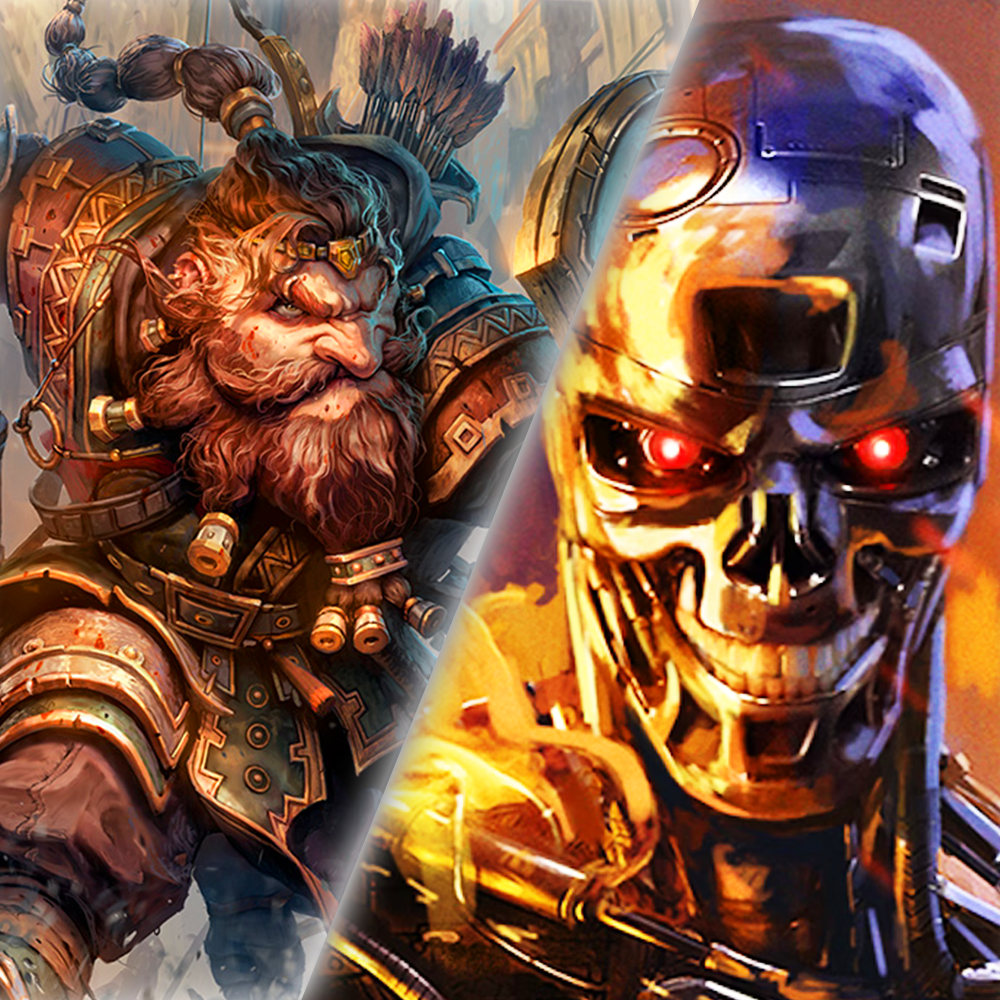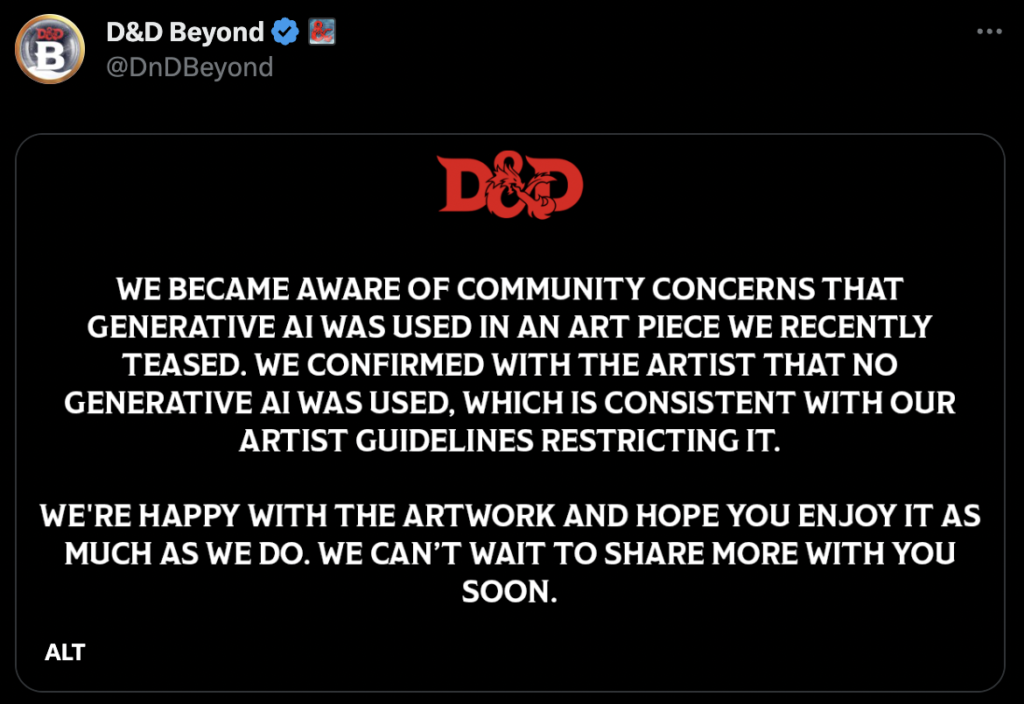
Over the past couple weeks, the tabletop social media and blogosphere experienced a one-two punch of Generative AI art scandals from the TTRPG industry. This began with the accusation of AI art being used in the new Dungeons and Dragons player handbook (later reported to be false), and was followed by the discovery of AI art by Nightfall Games in the new Terminator RPG. In both cases, the suspicion of AI-generated art played a major role in the unraveling of heated debate and outrage.
WotC Hit With Accusations of AI Art over the new Players Handbook
In the first instance, the Dungeons and Dragons twitter account (@Wizards_DnD) posted a promotion for the new Players Handbook to be release in 2024, along with an illustration of a dwarf running through battle. This coincides with plans by Wizards of the Coast to release a new wave of books for an augmented 5th edition (something of a 5.5th edition release).
Reactions were mixed. While sheer excitement brewed for the new chapter in DNDs long history, multiple critics voiced concerns about the new edition and the art used. Some fans took to Youtube in a mixture of reactions both lukewarm and pessimistic. Most notably, Indestructoboy (Taron Pounds), a content creator who focuses on tabletop RPG content, stated a strong feeling that the art was done by generative AI, pointing to the lack of an arm on the shield-bearing side of the dwarf.
Wizards responded to the multiple accusations from concerned fans, confirming that “no generative art was used”, restating their policy against accepting art done with generative AI. Many quickly pointed out that the art belonged to Nestor Ossandón, a long-time artist who worked with Wizards on multiple occasions, including multiple Magic the Gathering sets.
In the midst of the controversy, postings revealed art was authentic, showing multiple phases of illustration and painting in creation of the piece. Realizing the mistake, Taron took down his video and issued a public apology. This was supplemented with a private correspondence between Taron and Nestor in order to mediate the situation, and it seems at this point that the mistake has been remedied.



Nightfall Games Confirms AI Art Discovered in T2 RPG
Then, there’s the matter of the Terminator 2: Judgement Day RPG, a tabletop game about a rogue AI declaring war against humanity with robotic soldiers parading in human tissue. There was immense temptation by commenters and bloggers to state the irony of the situation, but the issue was anything but comedic to Nightfall Games, the publishers of the project.
In the course of the development of T2’s core rulebook, one of Nightfall Games designers raised concerns that one of the submitted art pieces was AI generated. After multiple contacts with the artist, the team received repeated claims that the art was not AI generated, instead using collages which were painted over with Photoshop. The publisher decided to test this claim by running the submissions through software designed to detect AI art. … The results were shocking!
Nightfall Games discovered that not only was the piece in question a 99.9% match for Midjourney AI art, about 15 other pieces commissioned by the same artist also matched. The team made the quick decision to scrap the art, and issue a formal notice to backers of the project.
The Growing Problem of AI Art
In Nightfall Games’s full explanation, they state that the swiftness of their response was driven by their steadfast position that using generative AI art is theft. This stance aligns with a massive number of individuals on the controversy of this technology.
The act of professionally using art algorithmically generated from a massive inventory of images scraped off the internet with no care of who the artist is, who owns the intellectual property, and no care for the days, weeks, and sometimes months of effort it takes to create some pieces of art… is not just a huge problem legally, it is deeply immoral.
This has been a growing concern for not just the tabletop publishing industry, but for adjacent industries that utilize art in products and materials. For example, earlier in 2023, Spiel Essen, Europes largest TTRPG convention hosted in Germany, was caught using generative AI for artwork used in promotional materials, including posters, tickets, and their mobile app.
While the accusations against Wizards of the Coast about the dwarf running through battle turned out to be false, the suspicion of such an action by WotC is not without merit. Also in 2023, it was confirmed that a freelance artist for Bigby Presents: Glory of the Giants had used algorithmic generation for artwork used in the book. In response, WotC updated their stance on algorithmic generation, and stated that the artwork would be replaced in their DnD Beyond version.
It is clear that since the emergence of tools such as Dall-E 2, Midjourney, and Nightcafe, art generated through algorithm has caused an upheaval, even in situations where it proved not to be present.
In response, some companies have come out with strong stances against endorsing projects with this kind of art. The crowdfunding platform, Backerkit, has chosen to put their foot down and disallow projects that utilize generative AI for its art. However, it is uncertain how steadfast companies will enforce such policies, and how effective their efforts may be in the long run, but we have plenty of cases to expect in 2024 to know for sure.
A Troubling Reality Revealed
These and many more situations speak to consumers distrust of companies to remain ethical during this time of generative AI. It is fortunate that we have some companies who are quick to act in the situation when such a case is discovered. However, the increasing cases of such art making it through to later stages in development is a problem.
These events reveal knowledge gaps taking place in the industry in how their art is sourced and made. Events like these either occur in lack of oversight, or because the requirements or resources to review and audit submissions are lacking. This is not to mention that many company executives in the industry have every temptation to take advantage of the technology in ways that ultimately undermine these ethics.
Does it come to any surprise that these problems are occurring at a time when art directors and editors find themselves either overworked, or laid off from their positions? (see related article)
Most of all, this technology enables an abysmal and short-sighted realm of thought about artwork. Rather than treating art as an honest expression of human ingenuity that takes passion, time, and attention to detail to produce, proponents of this technology tend to view art merely as a product or utility. It is not uncommon to find individuals justifying companies use of these algorithms, suggesting that it does not “steal” anything; it merely creates works “inspired”, “in the style of”, or remixed to be “original”.
However, the broad consensus by artists and creators is clear; when analyzing what occurs when a prompt is typed and the button is pressed, despite all that is concealed in the “black box” of algorithmic generation, the core mechanic is ultimately theft. It is a stripping of already created works, strewn together in ways the user doesn’t see directly. That lack of sight doesn’t justify the product that comes out on the other end.
Much has happened as a result of generative AI, but we are still incredibly early in the age that this tech is bringing into the world. Not only will these tools grow in use (and misuse), many more scandals and mistakes will be hitting the TTRPG industry in the coming years, creating an even more uncertain landscape for publishers, editors, artists, and watchful consumers alike.
Doom and gloom? What can be done?
In my not-so-humble opinion, … despite how scary the exploitative nature of this technology is in its current form, we have to remember that technologies that create disruption in the wrong places need to face a reckoning before a technology (and its use) can change.
This reckoning has to come from many places at once:
Artist outcry. Consumer action. Community auditing of publications. Developing and using AI detection tools. Policy enforcement. Public pressure. Industry regulation.
The turmoil caused by cases like the ones mentioned above are distressing, but each case has found itself under a spotlight for the same reason; public backlash. It is clear that artists and the TTRPG community won’t stand aside and let these situations go unnoticed, and go without reprimand.
It’s hard to say whether this rendition of algorithmic generation will ever face the same penalties that copyright infringement, intellectual property theft, and similar charges inflict in a judicial way. Unfortunately, many of the identified sources of this art are unable to bring such claims into a legal setting for lack of being able to afford a legal battle. At some point, such cases will have to take place before the consequences become real to those who see only benefit in using the technology in the way its being built and used.
There is one thing for certain in my mind; the backlash is justified.
When applied strategically, is a necessary weapon to penalize mass-theft of works in an industry setting. It should be made clear that if you give a black box the ability to launder a sin, using the black box becomes a sin. Using what comes out of the other end becomes a sin. The black box does not justify the output; it simply hides the crime.
Happy new years! … Lots of turbulent things to expect in 2024.
Feel free to check out our other recent article on Hasbros layoffs started in December 2023.
Otherwise, if you’re looking for a nice distraction, jump into these great topics about worldbuilding:
- d100 City Encounters and Urban Sidequests - April 26, 2025
- Dirtbags! a Sci-Fi Shooter RPG: Gameplay Review! - March 23, 2025
- Nerds and Knights: a TTRPG “Nerd Nite” Presentation - February 28, 2025


